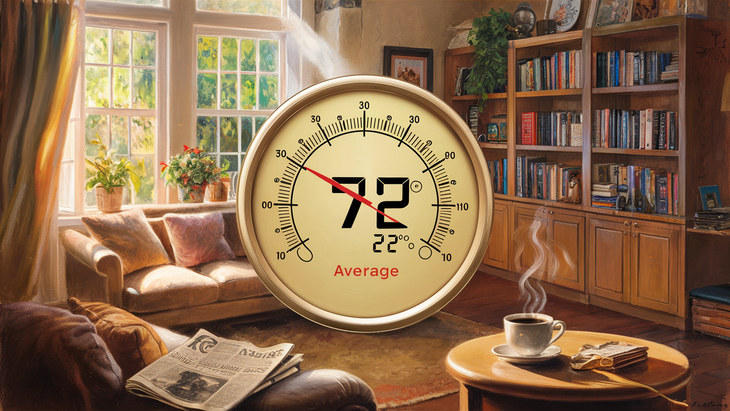
Maintaining an optimal room temperature is crucial for comfort, health, and energy efficiency. The concept of average room temperature may seem straightforward, but it involves various factors, including personal preferences, climate conditions, and the specific use of the space. This comprehensive guide explores the average room temperature, its significance, and tips for achieving and maintaining it.
Understanding Room Temperature
Room temperature generally refers to the range of air temperatures that most people find comfortable indoors. It varies depending on the context, such as geographic location, season, and individual comfort preferences. The commonly accepted range for room temperature is between 20°C to 22°C (68°F to 72°F).
Factors Influencing Room Temperature Preferences
Several factors influence what is considered a comfortable room temperature, including:
1. Geographical Location: People living in colder climates might prefer higher indoor temperatures, while those in warmer climates might be comfortable with lower temperatures.
2. Season: During winter, indoor temperatures are often set higher to compensate for the cold outside, whereas in summer, lower temperatures are preferred.
3. Humidity Levels: Humidity can affect how warm or cold a room feels. Higher humidity makes the air feel warmer, while lower humidity can make it feel cooler.
4. Activity Levels: The level of physical activity influences temperature preferences. More active individuals may prefer cooler temperatures, while sedentary activities might necessitate warmer conditions.
5. Clothing: The type and amount of clothing worn indoors also play a significant role. Lighter clothing may require warmer room temperatures, while heavier clothing allows for cooler settings.
6. Age and Health: Older adults and individuals with certain health conditions may have different temperature preferences and needs compared to younger, healthier individuals.
Ideal Room Temperatures for Different Rooms
Different rooms in a house serve various purposes, and their ideal temperatures can vary accordingly. Here’s a breakdown of optimal temperatures for common rooms:
1. Living Room: The living room is a space for relaxation and socializing. An average temperature of 20°C to 22°C (68°F to 72°F) is generally comfortable for most people.
2. Bedroom: Cooler temperatures are often preferred for sleeping. An optimal range is 16°C to 20°C (60°F to 68°F). A cooler environment can improve sleep quality and reduce restlessness.
3. Kitchen: The kitchen can get warm from cooking activities. A slightly cooler temperature of around 18°C to 20°C (64°F to 68°F) is recommended.
4. Bathroom: A warmer temperature of around 22°C to 24°C (72°F to 75°F) is ideal for comfort after bathing or showering.
5. Home Office: For productivity, a comfortable temperature of 20°C to 22°C (68°F to 72°F) is suitable, ensuring that the environment is neither too hot nor too cold.
The Importance of Maintaining an Optimal Room Temperature
Maintaining the right room temperature is crucial for several reasons:
1. Comfort: A comfortable temperature enhances overall well-being and productivity. Too hot or too cold environments can lead to discomfort and distraction.
2. Health: Extreme temperatures can negatively impact health. Too cold environments can increase the risk of respiratory issues, while overly warm conditions can cause dehydration and heat exhaustion.
3. Sleep Quality: Proper room temperature is essential for good sleep. Cooler temperatures promote deeper sleep and help regulate the body’s natural sleep-wake cycle.
4. Energy Efficiency: Maintaining an optimal temperature can lead to energy savings. Overheating or overcooling a space results in unnecessary energy consumption and higher utility bills.
Tips for Achieving and Maintaining the Average Room Temperature
Here are some practical tips for achieving and maintaining the optimal room temperature in your home:
1. Use a Programmable Thermostat: A programmable thermostat allows you to set temperatures for different times of the day, ensuring comfort and energy efficiency. You can program it to lower the temperature at night or when the house is empty.
2. Insulate Your Home: Proper insulation helps maintain a consistent indoor temperature by reducing heat loss in winter and heat gain in summer. Check for drafts and seal gaps around windows and doors.
3. Ceiling Fans: Ceiling fans can help circulate air, making rooms feel cooler in the summer and distributing warm air in the winter. Ensure they are set to rotate counterclockwise in the summer and clockwise in the winter.
4. Window Treatments: Use curtains or blinds to regulate temperature. In the summer, close them during the hottest part of the day to block out heat. In the winter, open them during the day to let in sunlight and close them at night to retain heat.
5. Humidity Control: Use a humidifier or dehumidifier to maintain optimal humidity levels. Aim for a relative humidity of 30-50% for comfort.
6. Regular Maintenance: Ensure your heating and cooling systems are regularly serviced to operate efficiently. Clean or replace filters as needed to maintain good air quality and system performance.
7. Zone Heating and Cooling: If possible, use zone heating and cooling systems to control temperatures in different areas of the house independently. This approach saves energy and enhances comfort by heating or cooling only the occupied areas.
8. Dress Appropriately: Adjust your clothing according to the season and indoor temperature. Layer clothing in the winter for added warmth and wear lightweight, breathable fabrics in the summer.
Conclusion
Understanding and maintaining the average room temperature is essential for comfort, health, and energy efficiency. While the ideal temperature can vary based on personal preferences, geographical location, and specific room usage, the generally accepted range is between 20°C to 22°C (68°F to 72°F). By considering factors such as insulation, humidity control, and the use of programmable thermostats, you can achieve and maintain a comfortable and efficient indoor environment. Remember, the key is to find a balance that meets your comfort needs while optimizing energy use.
Protect what matters most. Dial +1 888-805-5456 for the best home security solutions.


